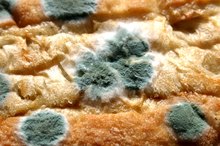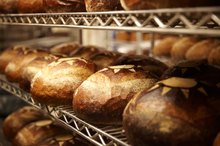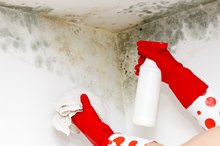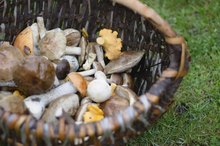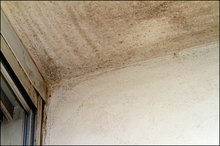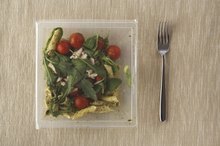What does fact checked mean?
At Healthfully, we strive to deliver objective content that is accurate and up-to-date. Our team periodically reviews articles in order to ensure content quality. The sources cited below consist of evidence from peer-reviewed journals, prominent medical organizations, academic associations, and government data.
The information contained on this site is for informational purposes only, and should not be used as a substitute for the advice of a professional health care provider. Please check with the appropriate physician regarding health questions and concerns. Although we strive to deliver accurate and up-to-date information, no guarantee to that effect is made.
How Does Mold Affect Food?
If you're contemplating eating the last piece of bread and notice just a bit of mold on the crust, cutting it off and eating the bread anyway might seem like a viable solution. You might regret it, though, because mold can make you sick, and its roots extend farther into a food than you can see. Although you can safely cut mold off some foods, it's risky to do so in others. "When in doubt, throw it out" is the safest motto.
If you are experiencing serious medical symptoms, seek emergency treatment immediately.
Types of Mold
Mold exists in more than 300,000 forms, but the harmful byproducts of molds, called mycotoxins, number only 30 or so. As much as 25 percent of the world's food is contaminated with mycotoxins, the Food and Agriculture Organization of the United Nations estimates. Grain and nuts are most often contaminated with mold, but produce such as apples and grapes can also be sources of mold.
Effects
What Happens if You Eat Mold Spores?
Learn More
Not all types of mold on food can make you sick. Molds such as Penicillium roqueforti create cheeses such as blue, Stilton and Roquefort cheeses. However, molds such as aflatoxin, which infects corn and peanuts, among other foods, can increase your risk of developing cancer. Regulatory agencies such as the U.S. Food and Drug Administration and the U.S. Department of Agriculture monitor aflatoxin levels in peanuts and corn. Other toxins, such as ergot, can cause hallucinations and other neurological issues. Mycotoxins can also cause gastrointestinal, skin and vision side effects. People with compromised immune systems, the elderly and the very young are most susceptible to mycotoxin infections upon exposure.
- Not all types of mold on food can make you sick.
- However, molds such as aflatoxin, which infects corn and peanuts, among other foods, can increase your risk of developing cancer.
Eating Foods With Mold
Molds often affect foods far below the surface mold you can see and scrape off, which means it could spread to where you can't see it, so scraping off the mold often isn't enough to ensure you won't consume any of it. It is safe to cut mold off of harder cheeses, such as cheddar and Colby, because the mold can't spread that far into them. Cut away at least an inch, not only around the mold, but also below the moldy spot, registered dietitian Katherine Zeratsky of MayoClinic.com recommends 1. Molds can grow beneath the surface in cooked casseroles, lunch meats, grains -- including bread -- jams, fruits and peanut butter. Do not eat these even if you remove the moldy area.
- Molds often affect foods far below the surface mold you can see and scrape off, which means it could spread to where you can't see it, so scraping off the mold often isn't enough to ensure you won't consume any of it.
- It is safe to cut mold off of harder cheeses, such as cheddar and Colby, because the mold can't spread that far into them.
Consideratrions
Safe Foods to Eat With a Mold Allergy
Learn More
If a food develops mold, don't even sniff it to see if it smells spoiled. Molds can enter the respiratory tract and cause respiratory problems. If one food in your refrigerator is contaminated by mold, check nearby foods because mold spores spread easily and quickly.
- If a food develops mold, don't even sniff it to see if it smells spoiled.
- If one food in your refrigerator is contaminated by mold, check nearby foods because mold spores spread easily and quickly.
Related Articles
References
- MayoClinic.com; "Moldy Cheese: Is It Unsafe to Eat?"; Katherine Zeratsky; February 2011
- Borchers AT, Chang C, Eric gershwin M. Mold and Human Health: a Reality Check. Clin Rev Allergy Immunol. 2017;52(3):305-322. doi:10.1007/s12016-017-8601-z
- Balmes JR. Chapter 107. Molds. In: Olson KR. eds. Poisoning & Drug Overdose, 6e, New York, NY: McGraw-Hill; 2012.
- Bozek A, Pyrkosz K. Immunotherapy of mold allergy: A review. Hum Vaccin Immunother. 2017;13(10):2397-2401. . doi:10.1080/21645515.2017.1314404
- Cipriani F, Calamelli E, Ricci G. Allergen Avoidance in Allergic Asthma. Front Pediatr. 2017;5:103. doi:10.3389/fped.2017.00103
- Chinoy B, Yee E, Bahna SL. Skin testing versus radioallergosorbent testing for indoor allergens. Clin Mol Allergy. 2005; 3:4. Clinic Rev Allerg Immunol (2017) 52:305–322. doi:10.1186/1476-7961-3-4
- Edmondson, DA. Allergy and “toxic mold syndrome.” Ann Allergy Asthma Immunol. 2005 Feb;94(2):234-9. doi:10.1016/S1081-1206(10)61301-4Get
- Coop, CA. Immunotherapy for Mold Allergy. Clinic Rev Allerg Immunol (2014) 47:289–298. doi:10.1007/s12016-013-8389-4
- Centers for Disease Control & Prevention. Mold Prevention Strategies and Possible Health Effects in the Aftermath of Hurricanes and Major Floods. Published June 9, 2006.
- Amirhosein Ghaffarianhoseini, Husam AlWaer, Hossein Omrany, Ali Ghaffarianhoseini, Chaham Alalouch, Derek Clements-Croome & John Tookey (2018) Sick building syndrome: are we doing enough?. Architectural Science Review,61:3, 99-121.
- American College of Allergy, Asthma & Immunology. Mold Allergy. Reviewed April 23, 2018.
- Centers for Disease Control and Prevention. Fungal Diseases. Reviewed May 6, 2019.
- Centers for Disease Control and Prevention. Mold. Basic Facts. Reviewed December 20, 2017
- Asthma and Allergy Foundation of America. Mold Allergy. Reviewed October 2015.
- Centers for Disease Control and Prevention. Molds in the Environment. Rreviewed December 20, 2017.
- Asthma and Allergy Foundation of America, Mold Allergy
- Centers for Disease Control and Prevention (CDC), Mold, Basic Facts
- Rudert A, Portnoy J.Mold allergy: is it real and what do we do about it?Expert Rev Clin Immunol. 2017 Aug;13(8):823-835. doi: 10.1080/1744666X.2017.1324298. Epub 2017 May 17.
Writer Bio
A registered nurse with more than 25 years of experience in oncology, labor/delivery, neonatal intensive care, infertility and ophthalmology, Sharon Perkins has also coauthored and edited numerous health books for the Wiley "Dummies" series. Perkins also has extensive experience working in home health with medically fragile pediatric patients.
